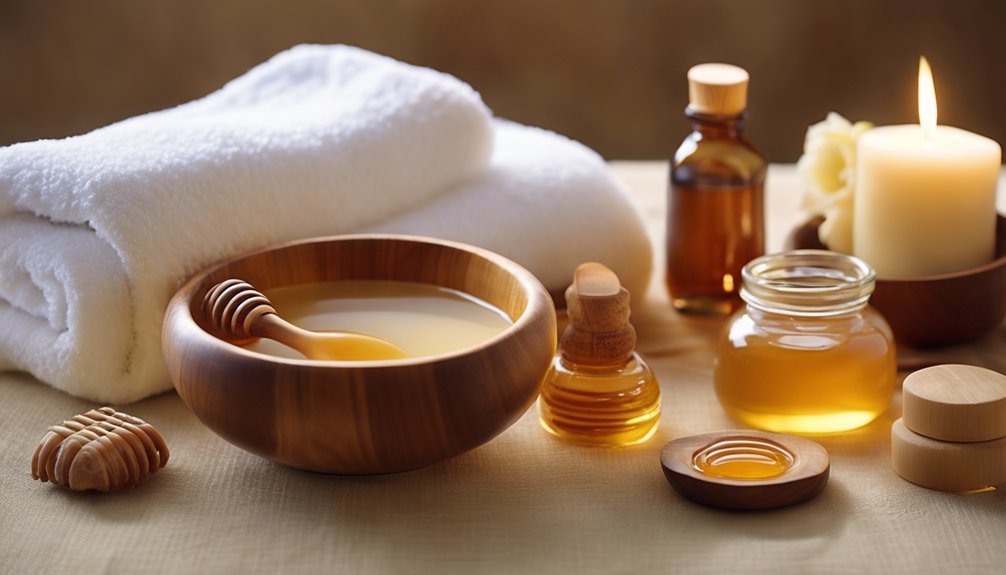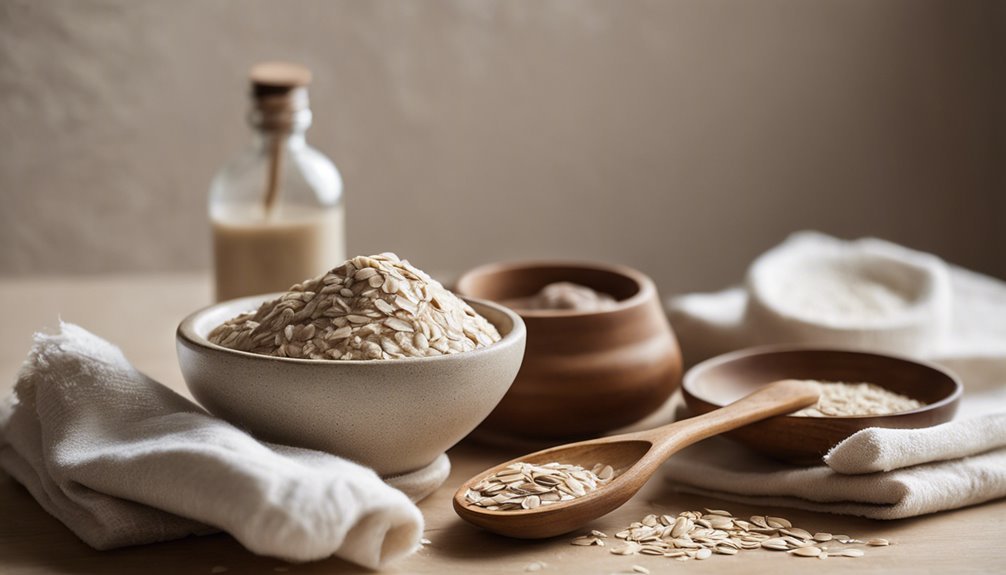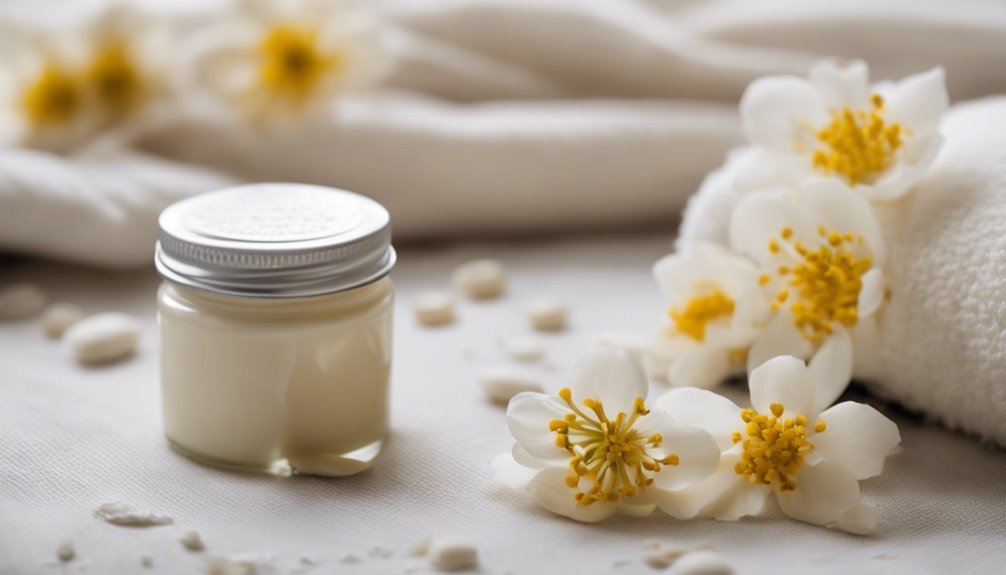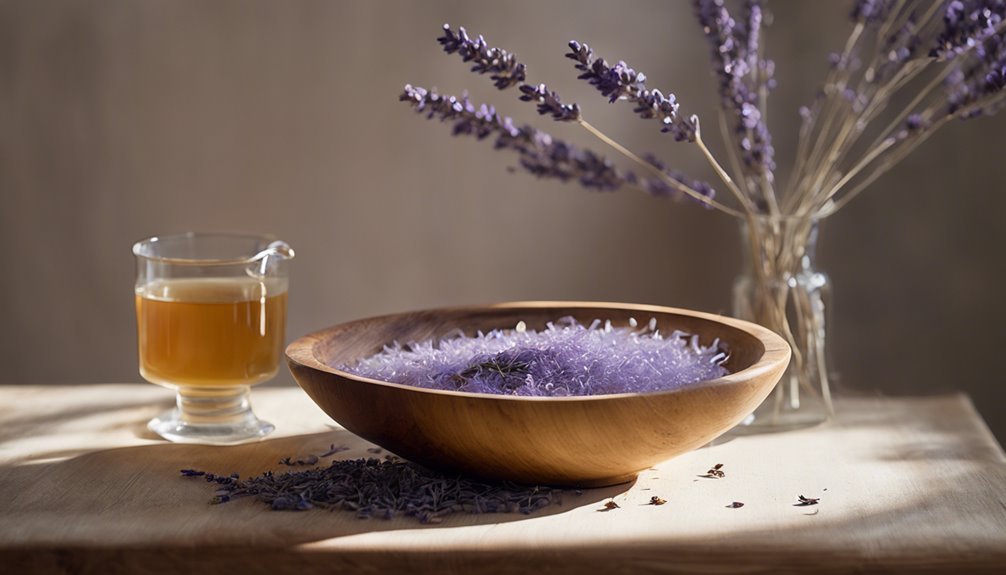Did you know that your kitchen holds the secret to healing those painful cracked heels? You're not alone in your struggle with dry, splitting skin on your feet, and nature offers some of the most potent remedies right at your fingertips. From a soothing honey and milk soak to a rich olive oil rub, these natural ingredients can transform your feet, making them soft and supple. But the true magic lies in how these treatments synergize to not only repair but also protect your skin. Curious about how to weave these ingredients into a foolproof routine? Let's explore how you can create a regimen that keeps those cracks at bay.
Key Takeaways
- Soak feet in a mixture of warm milk and honey to soften and exfoliate dead skin.
- Massage warm olive oil into heels and wear cotton socks overnight for deep moisturization.
- Apply an exfoliating paste made from ground oatmeal, honey, and water to remove dead skin and hydrate.
- Use a foot bath with dissolved Epsom salt to detoxify and soften heels, followed by gentle scrubbing.
- Regularly apply natural moisturizers like shea butter to maintain hydration and prevent future cracks.
Understanding Cracked Heels
Cracked heels, medically known as heel fissures, often result from a combination of pressure and dry skin. You might notice this particularly if you're standing for long hours, which increases pressure on the fat pad under your heel, causing it to expand sideways. If your skin lacks moisture, this expansion leads to cracking.
The primary causes of cracked heels include walking barefoot or wearing open-backed sandals, which expose your feet to harsh environments. This can strip your skin of essential oils, leading to dryness and fissures. Harsh soaps and long, hot showers might exacerbate the problem by further stripping moisture from your skin.
Symptoms of cracked heels are visible and easy to identify. You'll see a thickened area of dry skin around the rim of your heel, often of a darker color compared to the rest of your foot's skin.
These fissures, if left untreated, can become deep, painful, and may even bleed, particularly when further strain is placed on your heels.
Understanding these causes and symptoms empowers you to take proactive steps towards prevention, ensuring you maintain healthy, supple skin on your feet and provide the best care for those you serve.
Benefits of Natural Remedies
Natural remedies offer a host of benefits for treating cracked heels, particularly when you're seeking a gentle and sustainable approach. Utilizing natural ingredients can be highly effective, considering their minimal risk of side effects compared to synthetic options.
These treatments often draw on holistic healing principles, aiming not just to remedy the symptom but to nurture the overall health of your skin. When you use natural substances like plant-based oils or herbal extracts, you're applying components that are biocompatible with your body's own biological processes. This harmonization can enhance skin repair and hydration, leading to more resilient skin.
Additionally, natural remedies tend to be environmentally friendly. They typically require less processing and fewer chemicals, reducing your ecological footprint.
Moreover, turning to nature's solutions can empower you to take control of your health care, understanding exactly what you're applying to your body. This knowledge is particularly valuable when you're committed to caring for others, as it allows you to share safe, tested methods within your community.
Incorporating these approaches can foster a deeper connection to natural living, encouraging a lifestyle that respects and integrates the healing powers of the environment. This not only benefits your skin but also contributes to a holistic sense of well-being.
Honey and Milk Soak

One effective method for treating cracked heels is a honey and milk soak. The natural ingredients in both honey and milk bring significant benefits for skin health, particularly for those struggling with dry, cracked heels.
Here's how you can prepare and use this remedy:
- Warm the Milk: Start by gently warming two cups of whole milk. Warm milk helps in better absorption of nutrients by the skin.
- Mix in Honey: Add one cup of pure honey to the warm milk. Honey benefits the skin due to its antibacterial properties and its ability to moisturize and soothe.
- Prepare the Soak: Pour the mixture into a basin that's large enough for your feet. Ensure the temperature is comfortable to avoid any skin irritation.
- Soak Your Feet: Immerse your feet in the basin for about 20 minutes. The milk properties, including its lactic acid, help in softening and exfoliating dead skin, making it easier to treat dryness.
After soaking, gently scrub the heels to remove dead skin, then rinse with clean, warm water.
Regular use of this soak can significantly improve the condition of your heels, leveraging the healing powers of both honey and milk.
Olive Oil Moisturizer
After treating your heels with a honey and milk soak, applying olive oil can further enhance skin hydration and repair. Olive oil is rich in vitamins E and K, antioxidants that are pivotal in skin healing and rejuvenation. Its hydrating properties stem from the oil's ability to penetrate deep into the skin, locking in moisture and softening the hard, cracked areas on your heels.
For effective olive oil application, warm a moderate amount of oil to body temperature. Ensure it's comfortably warm to touch but not hot, to maintain its therapeutic properties.
After drying your feet post-soak, gently massage the warm oil into your heels, focusing on particularly rough patches. This method not only distributes the oil evenly but also stimulates blood flow to the area, promoting healing.
To optimize the olive oil benefits, cover your feet with cotton socks overnight. This practice aids in maximizing absorption, ensuring that the skin remains moisturized and can repair more effectively.
In the morning, you'll notice your heels feeling softer and looking healthier. Regular application of olive oil as a moisturizer can significantly alleviate the discomfort of cracked heels and enhance their appearance.
Oatmeal Exfoliating Paste

If you're looking to gently remove dead skin cells from your cracked heels, consider using an oatmeal exfoliating paste. This natural remedy leverages the oatmeal benefits to not only soothe but also effectively exfoliate your skin, promoting healthier and smoother heels.
Here's how you can create and use an oatmeal exfoliating paste:
- Mix Ingredients: Combine 2 tablespoons of ground oatmeal with a teaspoon of honey and a little water to form a thick paste. Honey acts as a humectant, promoting moisture retention in the skin.
- Apply the Paste: Gently rub the paste onto your cracked heels. The granular texture of the oatmeal works as a natural abrasive, helping in sloughing off dead skin cells.
- Let it Sit: Allow the mixture to sit on your heels for about 20-30 minutes. This duration lets the oatmeal's anti-inflammatory properties soothe the skin.
- Rinse Off: Wash the paste off with cool water and dry your feet thoroughly.
Using this exfoliation technique regularly can be quite effective. The oatmeal not only cleanses but also moisturizes, making it a dual-action remedy for dry, cracked heels.
Coconut Oil for Overnight Healing
Coconut oil serves as an effective natural treatment for cracked heels, particularly when used overnight. This natural emollient is rich in fatty acids that replenish moisture and create a barrier to protect your skin. By applying coconut oil before bed, you leverage its benefits during the body's prime healing time.
When you use coconut oil, its moisturizing properties work intensively. The oil penetrates deeply into the skin, repairing and hydrating the cracked areas. For optimal results, you should gently clean your feet, ensuring any dirt or dead skin is removed, perhaps following an exfoliation with an oatmeal paste. This preparation allows the coconut oil to absorb more effectively.
Apply a generous layer of the oil to your heels, massaging it in circular motions to enhance absorption and stimulate blood flow. After application, wear cotton socks to lock in the moisture and prevent your sheets from getting oily. This overnight application not only softens the skin but also promotes faster healing.
Incorporating this routine into your nightly regimen can significantly improve the condition of your heels, making them softer and more supple. Over time, the consistent use of coconut oil can fully restore the skin's integrity and prevent future cracking.
Shea Butter Foot Cream

While coconut oil offers an excellent overnight remedy for cracked heels, shea butter foot cream provides a rich, therapeutic alternative for daily use. Shea butter, derived from the nuts of the shea tree, is celebrated for its superior moisturizing properties, essential for repairing dry, cracked skin.
Here are the benefits of incorporating shea butter into your foot care routine:
- Intense Moisturization: Shea butter is an emollient, meaning it helps create a barrier on the skin that retains moisture. This is crucial for healing cracked heels.
- Anti-inflammatory Properties: Shea butter contains natural anti-inflammatory agents that reduce swelling and irritation of the skin around the heels.
- Skin Healing Components: Rich in vitamins A and E, shea butter promotes the regeneration of skin cells and improves skin elasticity.
- Soothing Effects: The creamy texture of shea butter provides a soothing application, enhancing the healing experience.
For effective results, apply shea butter foot cream using these techniques:
- Ensure your feet are clean and dry.
- Warm a small amount of cream between your hands to facilitate easier absorption.
- Massage gently into the heels, focusing on particularly dry areas.
- For best results, apply nightly and cover with cotton socks to maximize absorption.
Embracing shea benefits in your routine not only helps heal your heels but also serves as a preventive measure against further dryness and cracking.
Baking Soda Foot Bath
Many people find that a baking soda foot bath is an effective treatment for softening and cleansing cracked heels. Baking soda, or sodium bicarbonate, is a gentle exfoliant that helps remove dead skin cells and promotes healing. When you're looking to restore your heels to a smoother state, consider integrating this simple remedy into your foot care regimen.
To prepare a baking soda foot bath, you'll need approximately 3 tablespoons of baking soda dissolved in a basin of warm water. Ensure the water is comfortably warm but not too hot, as extreme temperatures can further damage sensitive skin. Soak your feet for about 15-20 minutes. The alkalinity of baking soda helps soften the hard skin, making it easier to exfoliate.
After soaking, gently use a pumice stone or foot brush to scrub your heels, focusing on the most affected areas. This process aids in removing the softened dead skin more effectively. Rinse your feet with clean water and dry them thoroughly.
It's crucial to moisturize immediately after to lock in hydration. Incorporating this treatment into your routine once or twice a week can significantly enhance the appearance and feel of your heels, contributing positively to your overall foot care practices.
Avocado and Banana Mask

Consider using an avocado and banana mask to nourish and heal your cracked heels. This natural remedy harnesses the moisturizing power of avocado and the plentiful nutrients found in bananas. Both ingredients aren't only accessible but also packed with properties that can significantly benefit skin health, especially for those dry and cracked areas.
Here's how you can prepare and use this mask effectively:
- Mash one ripe banana and one ripe avocado in a bowl until you achieve a smooth paste. This mixture will form the base of your mask.
- Apply generously to your heels, ensuring that all cracked areas are well-covered. The consistency of the paste will allow it to stay in place rather well.
- Leave the mask on for about 20 minutes. During this time, the avocado benefits your skin with its high oleic acid content, which deeply moisturizes and reduces inflammation.
- Rinse off with warm water and pat dry gently. Repeat this treatment regularly, about twice a week, to see improvement.
Banana nutrients, including potassium and natural oils, aid in hydration and promote skin integrity, enhancing the healing process of cracked heels.
This combined treatment offers a dual approach to tackling dryness and promoting skin recovery.
Epsom Salt Detox
After exploring the benefits of a natural avocado and banana mask for moisturizing cracked heels, you might also consider the advantages of an Epsom salt detox. Epsom salt, chemically known as magnesium sulfate, offers several detox benefits that are particularly beneficial for foot health.
Soaking your feet in an Epsom salt bath can help draw out toxins and reduce inflammation. This is crucial as inflammation can contribute to the worsening of cracked heels. The magnesium in Epsom salt promotes skin health by enhancing hydration and reducing irritation. This process not only detoxifies your skin but also softens the hardened skin on your heels, making it easier to exfoliate and subsequently heal.
To effectively use Epsom salt for your cracked heels, dissolve a half-cup of the salt in a tub of warm water. Submerge your feet for about 20 minutes. This allows ample time for the magnesium to be absorbed through your skin, optimizing the detox benefits.
After soaking, gently scrub your heels to remove dead skin. Regularly incorporating this Epsom salt detox into your care routine can significantly improve the condition of your heels while also providing a relaxing, therapeutic experience.
Apple Cider Vinegar Soak

While exploring natural remedies for cracked heels, you shouldn't overlook the potential benefits of an apple cider vinegar soak. Known for its antimicrobial properties, apple cider vinegar can help cleanse and disinfect cracked heels, potentially reducing the risk of infection.
Here's how you can effectively use an apple cider vinegar soak for your cracked heels:
- Prepare the Soak: Mix one part apple cider vinegar with two parts warm water in a basin. Ensure the water isn't too hot to prevent further skin damage.
- Soak Your Feet: Submerge your heels in the mixture for about 15-20 minutes. This allows the acidic nature of the vinegar to soften the dry, thick skin, making it easier to exfoliate.
- Gentle Exfoliation: After soaking, gently scrub the heels with a pumice stone or foot brush. This helps remove dead skin cells, enhancing the healing process.
- Moisturize: Immediately after drying your feet, apply a heavy moisturizer or heel balm to lock in hydration.
Utilizing apple cider vinegar not only offers a natural way to treat cracked heels but also ensures you're using a cost-effective and readily available remedy.
Preventing Future Cracks
Having explored natural treatments like apple cider vinegar soaks for healing cracked heels, it's equally important to focus on strategies to prevent these issues from recurring.
One critical preventive measure is understanding the importance of hydration. Maintaining adequate hydration is essential for skin elasticity and health. You should aim to drink at least eight glasses of water a day to keep your skin supple and prevent dryness that can lead to cracks.
Another significant factor is your choice of footwear. Opt for shoes that fit well and provide proper support. Avoid excessively tight or restrictive shoes, as they can increase pressure on your heels, making them more susceptible to cracking.
Instead, choose shoes with a cushioned sole and adequate room for your toes. During dry seasons or if you're prone to dry skin, consider wearing shoes with a closed heel to protect the skin from the elements.
Frequently Asked Questions
Can Wearing Specific Shoes Help Heal Cracked Heels Faster?
Yes, wearing shoes with proper heel support and made from breathable materials can indeed help heal your cracked heels faster.
Shoes that fit well and provide adequate cushioning reduce pressure and friction, promoting faster healing of the skin.
Opt for footwear with a supportive base and soft, natural fabrics that allow air circulation.
This choice can make a significant difference in your comfort and the healing process of your heels.
Are There Any Dietary Changes That Can Improve Heel Health?
Absolutely, dietary changes can significantly boost your heel health. Incorporating nutrient-rich foods that promote skin health, such as those high in vitamins A and E, can work wonders.
Don't forget the hydration benefits; drinking plenty of water helps maintain skin elasticity.
How Does Hydration Affect the Severity of Cracked Heels?
Hydration significantly impacts your skin's elasticity, affecting the severity of cracked heels.
When you're well-hydrated, your skin retains its suppleness, reducing the likelihood of cracking.
It's essential to maintain optimal hydration levels to ensure your skin remains healthy and resilient.
Aim to drink plenty of fluids throughout the day, especially water, to support your skin's hydration and overall health.
This approach is crucial in managing and preventing dry, cracked heels effectively.
Can Cracked Heels Indicate Other Health Issues?
Yes, cracked heels aren't just cosmetic concerns; they might be red flags signaling broader health issues.
They can indicate underlying skin conditions or, more seriously, a correlation with diabetes.
If you're noticing persistent or deep cracks, it's crucial to consult a healthcare professional.
They can provide an accurate diagnosis and appropriate treatment plan, ensuring you're not only treating the symptom but also addressing any potential health implications.
What's the Fastest Way to Heal Cracked Heels?
To rapidly heal cracked heels, you can employ several effective natural remedies and healing techniques.
Regularly moisturizing with coconut oil or shea butter deeply nourishes the skin.
Additionally, soaking your feet in lukewarm water with added honey or oatmeal can soften the skin, making it easier to remove dead skin with a pumice stone.
Ensure you dry your feet thoroughly after soaking to prevent further moisture loss.
Conclusion
Think of your feet as the foundation of your body's temple; maintaining them is essential for your overall well-being. By embracing natural remedies like honey, olive oil, and oatmeal, you're choosing to nourish and repair your skin with nature's own bounty. These treatments not only soothe and rejuvenate but also fortify your skin against future damage. Commit to this holistic care routine, ensuring your foundation remains strong and unblemished, ready to carry you forward with every step.




